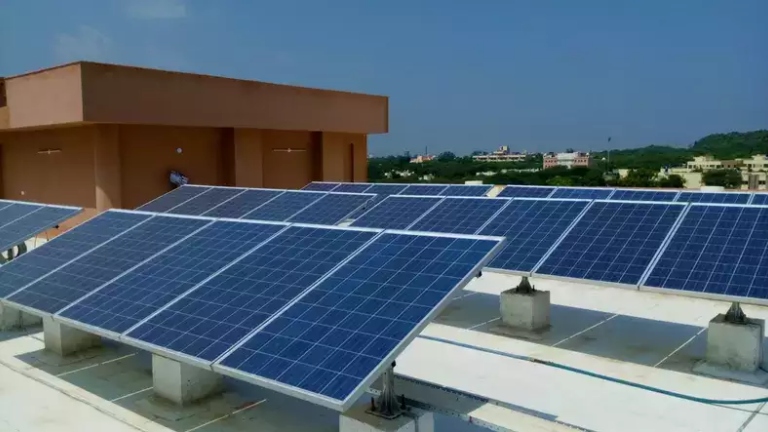India’s $1 Billion Solar Subsidy Plan Aims to Strengthen Domestic Manufacturing
India is preparing to launch a $1 billion Solar Subsidy Plan to accelerate domestic solar manufacturing and reduce reliance on Chinese imports. Spearheaded by the Ministry of New and Renewable Energy (MNRE), the plan will focus on scaling up wafer and ingot production, two critical components in the solar supply chain.
According to sources, the Solar Subsidy Plan has gained the support of top advisors in Prime Minister Narendra Modi’s office and is expected to be presented to the cabinet in the coming months. The initiative is part of a broader strategy to make India self-reliant in renewable energy manufacturing and position the country as a global solar hub.
Addressing the Gaps in India’s Solar Industry
India has rapidly expanded its solar energy sector, emerging as one of the largest renewable energy markets in the world. However, while the country has built strong solar module and cell manufacturing capacities, it remains heavily dependent on imports for wafers and ingots—components essential for producing high-efficiency solar panels.
Currently, India has only 2 gigawatts (GW) of wafer and ingot manufacturing capacity, largely developed by Adani Enterprises Ltd. In contrast, the country has a 71 GW capacity for solar modules and 11 GW for solar cells, creating a major gap in self-sufficiency.
The Solar Subsidy Plan aims to bridge this gap by encouraging domestic production, reducing import dependence, and fostering technological advancements in the solar manufacturing sector.
Reducing Dependence on Chinese Imports
India currently imports more than 80% of its solar components from China, making it vulnerable to global supply chain disruptions and price fluctuations. Despite imposing import tariffs and rolling out the Production-Linked Incentive (PLI) scheme, the absence of domestic wafer and ingot production remains a major hurdle.
The Solar Subsidy Plan is designed to strengthen India’s solar supply chain, enabling manufacturers to compete globally. However, even with increased wafer and ingot production, India will still need to import polysilicon, the raw material for these components.
At present, India has no domestic polysilicon manufacturing, while China dominates the global market, producing 2.3 million tons annually. By comparison, Germany—the second-largest producer—manufactures only 75,000 tons. To achieve full solar self-reliance, India may need to expand its strategy beyond wafers and ingots and invest in polysilicon production.
Replicating the Success of Mobile Manufacturing
India’s Solar Subsidy Plan follows the successful model of the mobile phone manufacturing industry, where government incentives attracted global tech giants like Apple Inc. and Samsung Electronics Co.
Through billions of dollars in financial incentives, India became a major production hub for smartphones, leading to a surge in iPhone exports and a boost in domestic job creation.
Officials believe a similar strategy can be applied to the solar sector, where targeted subsidies can attract large-scale investments in wafer and ingot production, fostering growth and self-reliance.
Challenges in Wafer and Ingot Manufacturing
Despite the promise of the Solar Subsidy Plan, industry experts highlight key challenges in domestic wafer and ingot production:
- High Manufacturing Costs – Wafer and ingot production requires advanced technology and large capital investments, making initial costs high.
- Quality Control Issues – Indian manufacturers need to meet global standards to compete with Chinese and European suppliers.
- Logistics and Supply Chain Gaps – India still lacks a robust ecosystem for sourcing raw materials and components, impacting scalability.
The Solar Subsidy Plan is expected to address these issues by providing financial aid, infrastructure support, and R&D funding to make domestic production cost-effective and globally competitive.
Aligning with India’s Renewable Energy Goals
India has set an ambitious target of 500 GW of non-fossil fuel capacity by 2030, with solar energy playing a key role in achieving this vision. Expanding domestic solar manufacturing is crucial for:
- Enhancing energy security and reducing import dependence
- Creating jobs in manufacturing, R&D, and installation
- Driving innovation in high-efficiency solar technologies
- Attracting foreign and domestic investment in the solar sector
By implementing the Solar Subsidy Plan, the government aims to build a strong foundation for India’s renewable energy future, ensuring long-term economic and environmental benefits.
What’s Next?
The Solar Subsidy Plan is expected to be reviewed by the cabinet soon. If approved, it will:
✔ Encourage domestic and foreign companies to set up wafer and ingot production units
✔ Reduce production costs, making India competitive in the global solar market
✔ Boost investment and technology transfer to accelerate local manufacturing growth
A spokesperson from the Ministry of New and Renewable Energy (MNRE) declined to comment on the ongoing discussions. However, government insiders indicate that the plan is a high priority, given India’s commitment to expanding its renewable energy sector.
Conclusion
India’s $1 billion Solar Subsidy Plan is a strategic move to strengthen domestic manufacturing, reduce reliance on Chinese imports, and drive solar energy adoption. While challenges such as raw material sourcing and quality control remain, this initiative has the potential to position India as a global leader in solar manufacturing.
With the cabinet expected to review the plan soon, this policy could mark a turning point in India’s renewable energy journey, fostering economic growth, technological advancement, and energy independence.







